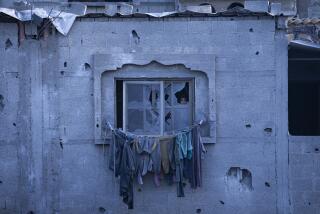Caucasus Fighting Masks Region’s Real Problem
- Share via
While it is both deeply tragic and highly strategic, the current shoot-out in the Caucasus is essentially a sideshow. The military aspects of the situation have little to do with the causes of the problem and may even less to do with its solution.The real issues are neither military nor religious. They are economic, and any enduring solution that might bring stability to this strategic region must be economic as well. Though federal troops have an important role to play in the present situation, Moscow’s lopsided military approach is leading it into the trap that was set by the brilliant Chechen insurgent warlord, Shamil Basayev. Basayev knows that while his forces are well-trained, well-armed and admirably financed, they are far too few to achieve a decisive victory in Dagestan.
More important, he knows that no one will rule the Dagestani people against their wishes. Contested areas of Dagestan are in rugged geography inhabited by hot-blooded mountaineers equipped with large quantities of arms, a culture of personal valor and a tradition of vendetta. Ultimately, Basayev can win only if he is able to recruit many Dagestanis to his side.
The majority of Basayev’s fighters are from Dagestan, though others are drawn from a host of Central Asian, Middle Eastern, Eastern European and African countries. Most of the Dagestanis fighting for Basayev are members of the Islamic fundamentalist sect commonly known as Wahhabis. The Wahhabis are led by Jordanian-born Emir Khattab. Khattab fought beside Basayev in the Chechen war, then married a Dagestani woman, led a group of central Dagestani villages in a violent, de facto secession from the Dagestani government and coordinated with Middle Eastern supporters to set up a guerrilla training base in Chechnya. He knows that his best recruiters, by far, are Dagestan’s economic collapse and the deepening desperation of its people, 80% of whom are currently unemployed.
The Wahhabis have attracted adherents because they offer an option to social and political corruption along with onerous pseudo-Islamic traditions. Yet the Wahhabis have long been violently opposed by Dagestan’s traditional Moslems, who together with smaller populations of Christians and Jews constitute well more than 90% of the population. By March 1999, only 3% of the Dagestanis were Wahhabi, but their ranks are likely to grow with the increasing misery level of the people.
Of course one sure way to make people more miserable is to bring a war to their territory. The invasion has already produced more than 10,000 refugees, whose numbers grow each day. The plight of these refugees is all the more severe since no international relief agencies have been able to operate in Dagestan for more than two years. The hostage industry, which originated in Chechnya after the war and quickly became the region’s leading source of revenue, forced out all international agencies before the end of 1997. Moreover, the situation is fraught with ethnic tension that could multiply the conflict among Dagestan’s 34 ethnic groups. Hence, with every day that they fight on Dagestani soil, Khattab and Basayev create more potential recruits for their forces.
Brilliantly, Basayev and Khattab are not fighting a war of attrition, but of amalgamation. Even if federal troops are successful in their campaign to dislodge the insurgents, the result is likely to be an indefinite future of border clashes and guerrilla raids that continue the process of destabilization and rebel recruitment.
Moscow would be better advised to recognize that the problem in Dagestan is fundamentally economic and that it therefore requires an economic solution. Moscow must move immediately to ensure that seldom-seen entitlements, such as pensions and unemployment benefits, are paid, and government programs reestablished, in order to stimulate the local economy.
If it is to regain any measure of stability in this historically strategic, oil-laden region, the West must ensure that relief is provided despite government corruption and adverse conditions. There are three strategies that can be pursued. First, relief agencies that formerly operated in Dagestan must mobilize Dagestani “locals” who previously staffed their offices usually under the supervision of Westerners. These local workers can be organized from afar to receive and distribute aid.
Second, Western groups and agencies can work on a grass-roots basis directly with Dagestani groups and organizations. This might also help to relieve the common Dagestani misconception that the United States is supporting the invaders.
Finally, diplomatic pressure must be applied to the governments of Saudi Arabia, Kuwait and Pakistan to persuade their citizens to stop financing the insurgents.
The Western media should follow the money. Much of those large sums that support the insurgents originate in societies that stand to profit from instability in the Caucasus. Increasingly, the West has been backing away from earlier investments in Caspian oil, partly because the instability of the region renders the transportation of that oil risky and difficult. Caspian oil reserves may not compare with those of the Persian Gulf countries, but the successful transportation of the former would reduce the capacity of the latter to control the price of oil. Is it therefore merely coincidence that the invasion is being financed by residents of Persian Gulf states who profit from the sale of oil? Perhaps it is, but this is a question that should be investigated.
More to Read
Sign up for Essential California
The most important California stories and recommendations in your inbox every morning.
You may occasionally receive promotional content from the Los Angeles Times.










